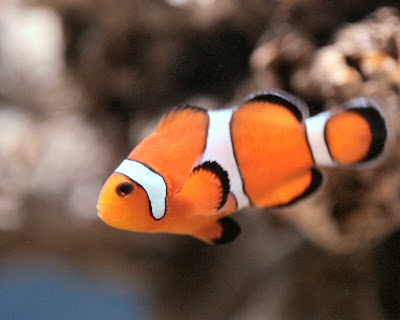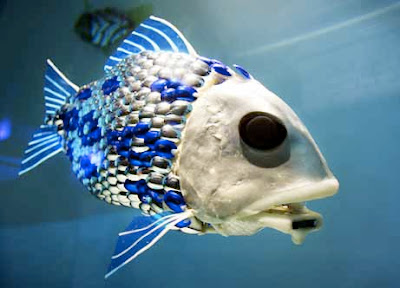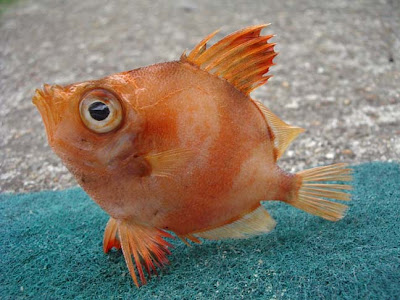A fish is an organism that consists of all aquatic animals bearing gills, skull and mostly backbone along with fin-shaped limbs, if any. Traditionally referred as pisces, this organism can be found in abundant in almost every body of water – be it high mountain streams or abyssal or deep into the heart of the ocean (hadal zones). Most of these creatures are cold blooded. The temperature of their body varies with the change in ambient temperatures. Few exceptions include large active swimmers such as tuna and white shark, which have the ability to keep up to a higher core temperature.
Having streamlined body that supports rapid swimming, this organism extracts oxygen using gills from water or makes use of accessory breathing organ for taking in atmospheric oxygen. The other typical physical traits of this aquatic animal include two sets of paired fins, one or two dorsal fins, a tail fin and an anal fin along with jaws and skin covered with scales. Most of these aquatic animals lay eggs.
It is to be noted that not all aquatic animals referred to as fish are fish as per the biological definition. Some of the examples of these non-fish organisms in the water include whales, dolphins, jellyfish, starfish, shellfish, cuttlefish, crayfish, seals, crocodiles, hippopotamuses, etc. According to aquaculture, finfish are considered as true fish. Also, fishes with fin enable people to distinguish between true fish and these other mammals.
Compared to any other group of vertebrates, fish exhibit great diversity with 32,000 species. These species vary in blood temperature, swimming performance, oxygen extraction techniques, body shape and arrangement of fins, skin surfaces, size, etc. For instance, some species of shark along with tuna and swordfish exhibit warm blooded adaptations by managing to heat their bodies above the ambient temperature. Also, few species like salmon, jack and tuna boast great streamlining and swimming performance covering 10 to 20 body-lengths per second. On the other hand, species such as eels and rays are capable of swimming only 0.5 body-lengths per second.
When it comes to extraction of oxygen, numerous freshwater organisms using different structures breathe oxygen from water as well as air. In fact, many of the species have different organs for the same function. Some of the examples include Lungfish with paired lungs, catfish like Corydoras takes in oxygen through stomach or intestine and gouramis boasts labyrinth organ to breathe oxygen. Some fishes including seahorse, gulper, pufferfish and angler highly vary in body shape and arrangement of the fins. In addition to this, there are species without scales over skin like moray eels and with skin scales such as sharks, different fossil fish, etc. Also, the species vary in size ranging from 52 ft whale shark to a tiny 0.3 inches stout infantfish.
Thus, fish truly exhibit great diversity. They show diversity in oceanic water as well as freshwater ecosystem.
Having streamlined body that supports rapid swimming, this organism extracts oxygen using gills from water or makes use of accessory breathing organ for taking in atmospheric oxygen. The other typical physical traits of this aquatic animal include two sets of paired fins, one or two dorsal fins, a tail fin and an anal fin along with jaws and skin covered with scales. Most of these aquatic animals lay eggs.
It is to be noted that not all aquatic animals referred to as fish are fish as per the biological definition. Some of the examples of these non-fish organisms in the water include whales, dolphins, jellyfish, starfish, shellfish, cuttlefish, crayfish, seals, crocodiles, hippopotamuses, etc. According to aquaculture, finfish are considered as true fish. Also, fishes with fin enable people to distinguish between true fish and these other mammals.
Compared to any other group of vertebrates, fish exhibit great diversity with 32,000 species. These species vary in blood temperature, swimming performance, oxygen extraction techniques, body shape and arrangement of fins, skin surfaces, size, etc. For instance, some species of shark along with tuna and swordfish exhibit warm blooded adaptations by managing to heat their bodies above the ambient temperature. Also, few species like salmon, jack and tuna boast great streamlining and swimming performance covering 10 to 20 body-lengths per second. On the other hand, species such as eels and rays are capable of swimming only 0.5 body-lengths per second.
When it comes to extraction of oxygen, numerous freshwater organisms using different structures breathe oxygen from water as well as air. In fact, many of the species have different organs for the same function. Some of the examples include Lungfish with paired lungs, catfish like Corydoras takes in oxygen through stomach or intestine and gouramis boasts labyrinth organ to breathe oxygen. Some fishes including seahorse, gulper, pufferfish and angler highly vary in body shape and arrangement of the fins. In addition to this, there are species without scales over skin like moray eels and with skin scales such as sharks, different fossil fish, etc. Also, the species vary in size ranging from 52 ft whale shark to a tiny 0.3 inches stout infantfish.
Thus, fish truly exhibit great diversity. They show diversity in oceanic water as well as freshwater ecosystem.
Some Beautiful Fish Pictures
 |
| Fish |
 |
| Fish with hands |
 |
| Robot fish |

I’m impressed, I have to say. Really hardly ever do I encounter a weblog that’s both educative and entertaining, and let me inform you, you have hit the nail on the head. Your thought is excellent; the issue is one thing that not sufficient people are speaking intelligently about. I'm very glad that I stumbled throughout this in my seek for something relating to this. online casino games
ReplyDeleteNice post.
ReplyDeletehttps://alchetron.com/Tron/Guppy-Fish-%3F-A-Complete-Details-about-this-Familiar-Pet-Fish-5196995-UW#-